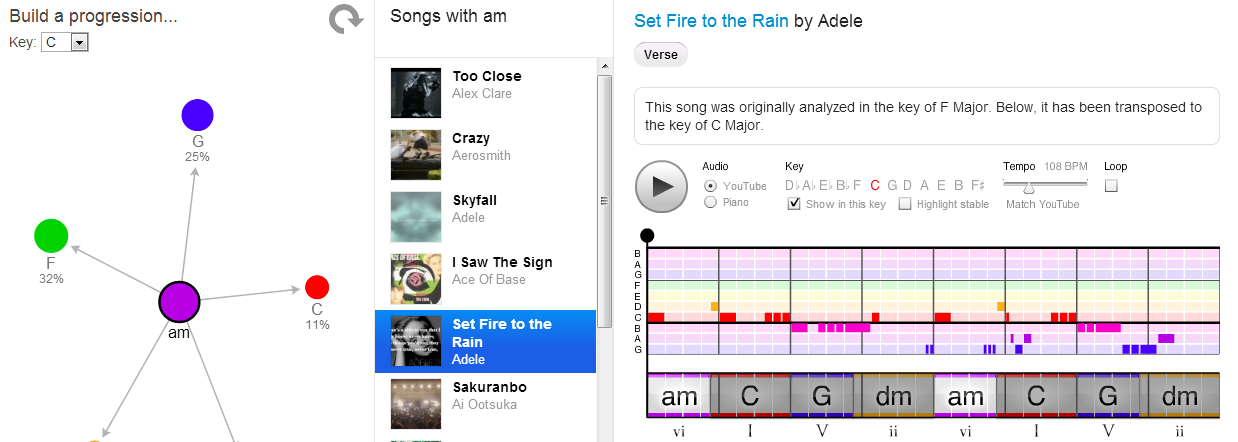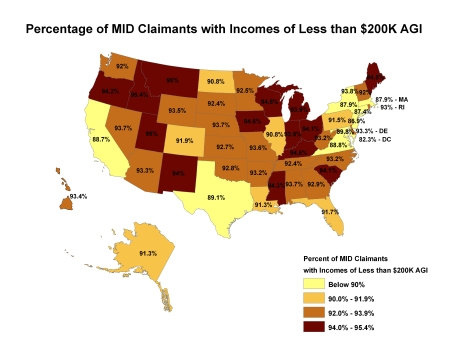 click to discover how your favorite song was constructed. Pick a chord, then another, then another – and it will display a list of songs written with that key, and a visualization of the notes and chords of that song.
click to discover how your favorite song was constructed. Pick a chord, then another, then another – and it will display a list of songs written with that key, and a visualization of the notes and chords of that song.
Emmanuel Fonte | Music | Art | Leadership
If music be the food of love, play on. Emmanuel Fonte website is about music, art, real estate, architecture, design and decor. Occasionally, I talk about my other passion, hockey.
The tax benefits of the mortgage interest deduction (MID) are primarily targeted to the middle class. According to 2012 Congressional estimates, 65.4 percent of the tax benefit is collected by households who have economic income of less than $200,000.
Of course, the claims for the MID are going to vary state-to-state given differences in house prices and other costs of living, household incomes, and tax items such as property taxes or state income/sales taxes, which in part determine whether a homeowner claims the standard deduction.
Fortunately, the Internal Revenue Service publishes state-level data of tax statistics. And these state level data, for which the income classifier is equal to adjusted gross income (AGI), illustrate the degree to which MID-benefiting taxpayers are concentrated in the middle class.
 The map above reports the share of taxpayers who claimed the MID on 2010 federal income tax return (the most recent data available) and who also report less than $200,000 in adjusted gross income. Not surprisingly, the share tends to drop somewhat in high cost states, such as New York and California, for which household incomes tend to be higher. Nationally for 2010, 91 percent of taxpayers claiming the MID has an AGI of less than $200,000.
The map above reports the share of taxpayers who claimed the MID on 2010 federal income tax return (the most recent data available) and who also report less than $200,000 in adjusted gross income. Not surprisingly, the share tends to drop somewhat in high cost states, such as New York and California, for which household incomes tend to be higher. Nationally for 2010, 91 percent of taxpayers claiming the MID has an AGI of less than $200,000.
Of course, income, homeownership status, and tax characteristics are not fixed across one’s life-cycle. For example, interest payments for a fixed rate mortgage are larger in the early years of a mortgage, thus the potential deduction amount for the MID is higher for recent homebuyers.
As a result of this life-cycle effect, many homeowners benefit from the MID for a series of years and then cease claiming the deduction as their interest payments fall and the standard deduction becomes a better deal. For this reason, the often cited statistic that only a quarter of taxpayers benefit from the MID is misleading. In fact, this claim should be qualified as “in a given year,” given the life-cycle impact.
By merging IRS data with Census American Community Survey data (both for 2010), we can estimate the more useful statistic of how many homeowners with a mortgage benefit from the MID in a given year. Nationally, 73 percent of homeowners with a mortgage claimed the MID on their income tax returns for tax year 2010.
It is important to note that this number is not an accounting of the percentage of homeowners who benefit from the MID during their tenure of homeowners. That percentage would be higher given life-cycle effects, but cannot be estimated without panel data of income tax returns.
View this original post on the NAHB blog, Eye on Housing
 Rent.com, a rental housing listing site, recently ranked the top 25 markets for new college grads, factoring in unemployment, cost of living, and annual mean wages. The following are the top 10 cities on its list (in no particular order), where young grads would most likely find housing, work, and a suitable paycheck.
Rent.com, a rental housing listing site, recently ranked the top 25 markets for new college grads, factoring in unemployment, cost of living, and annual mean wages. The following are the top 10 cities on its list (in no particular order), where young grads would most likely find housing, work, and a suitable paycheck.
Atlanta, Ga.
Mean annual income: $46,600
Median price for a one-bedroom apartment: $800
Boston, Mass.
Mean annual income: $57,500
Median price for a one-bedroom apartment: $1,590
Houston, Texas
Mean annual income: $47,500
Median price for a one-bedroom apartment: $800
Denver, Colo.
Mean annual income: $50,300
Median price for a one-bedroom apartment: $970
Minneapolis/St. Paul, Minn.
Mean annual income: $49,800
Median price for a one-bedroom apartment: $900
Seattle, Wash.
Mean annual income: $54,800
Median price for a one-bedroom apartment: $1,300
Dallas, Texas
Mean annual income: $46,200
Median price for a one-bedroom apartment: $900
Raleigh, N.C.
Mean annual income: $45,200
Median price for a one-bedroom apartment: $800
Washington, D.C.
Mean annual income: $62,900
Median price for a one-bedroom apartment: $1,600
St. Louis, Mo.
Mean annual income: $44,200
Median price for a one-bedroom apartment: $960
Source: “The Best Cities for New College Grads in 2013,” Forbes
 Freddie Mac recently released its U.S. Economic and Housing Market Outlook through March showing that as we head into the spring home buying season, continued low mortgage rates, increasing house prices, and gradually improving consumer confidence will help support increased home sales. A short preview video and the complete March 2013 U.S. Economic and Housing Market Outlook are available here.
Freddie Mac recently released its U.S. Economic and Housing Market Outlook through March showing that as we head into the spring home buying season, continued low mortgage rates, increasing house prices, and gradually improving consumer confidence will help support increased home sales. A short preview video and the complete March 2013 U.S. Economic and Housing Market Outlook are available here.
Outlook Highlights
• Compared to 2012, expect home sales to be up 8 to 10 percent for 2013.
• Expect housing starts to increase to 950,000 units for 2013, compared to 780,000 in 2012.
• In 2012, real estate added $1.5 trillion to balance sheets, and residential mortgage debt outstanding increased by 0.1 percent in the fourth quarter of 2012, indicating household deleveraging might be drawing to a close.
• Because of sequestration spending reductions, expect the unemployment rate in 2013 to average about 7.8 percent, essentially flat for the year or about 0.25 percentage points higher than it otherwise would have been.
• Regardless, the housing wealth effect is taking hold in the broader market which should translate into the healthiest spring home buying season since 2007.
“History shows us not all economic recoveries are created equal and consumer confidence mirrors this fact,” says Frank Nothaft, Freddie Mac vice president and chief economist.
“With the spring home buying season upon us, the recent highs in the stock market are a welcome signal of better times ahead. But it will be the gradually declining unemployment rate and steadily improving housing market that will deliver broad-based economic benefits for Americans and, in turn, support the overall recovery.”
For more information, visit www.FreddieMac.com
 Limited inventory and a very strong demand for housing has created an environment where bidding wars are commonplace in today’s real estate market. Homes priced properly are getting multiple offers within a short time of coming to market. This brings about a dilemma for the agent: How should they advise their client who is about to make an offer when other offers will also be presented?
Limited inventory and a very strong demand for housing has created an environment where bidding wars are commonplace in today’s real estate market. Homes priced properly are getting multiple offers within a short time of coming to market. This brings about a dilemma for the agent: How should they advise their client who is about to make an offer when other offers will also be presented?
Over the last several years, there wasn’t any pressure on the buyer to adjust their offer for three reasons:
They buyer could find another home easily for probably less money and a lower mortgage rate. There was no downside to not ‘upping the ante’. However, in today’s market, things have dramatically changed.
A normal real estate market has between 5-6 months worth of inventory. Over the last several years, the inventory of homes for sale had skyrocketed to 10 months. Most buyers in almost any price range had a multitude of houses to choose from. Today, the national month’s supply of inventory has fallen below five months. In many markets, there is not enough housing inventory to satisfy the current demand.
Conclusion: If the buyer loses the house they are bidding on, there is no guarantee they will find a similar home anytime soon.
Becausemof the limited inventory, home prices are again appreciating. The Case Shiller Pricing Index revealed that house prices rose by 6.8% in 2012. Experts are projecting home prices to increase by 5% to 8% in 2013.
Conclusion: If the buyer doesn’t get this house, there is a good likelihood that a similar home will cost more in the future.
The ‘cost’ of a home to a buyer is determined by the price of the house and the expense associated with the financing. Mortgage rates are projected to inch up in 2013. In a recent forecast, the Mortgage Bankers Association predicted that rates could climb as high as 4.3% by the end of the year.
Conclusion: If interest rates do inch up, the ‘cost’ of the next home could be impacted significantly.
If a buyer truly loves the house they are bidding on, it probably makes sense to raise their bid now instead of waiting for another dream house to appear.

In a suburb of Istanbul, a young couple requested a home interior that would unite their collection of antiques with a more modern aesthetic.GAD Architecture took up the challenge and created the impressive Buama House interior renovation.


The home has an appearance of being almost cave-like, enclosed and very comforting. The floors, walls and ceiling all seem to be continuous, with little delineation between them.


Rather than traditional walls and doors to separate each room, the home features multiple levels separated by smooth, low steps. Coupled with small recessed lights in the ceiling, this openness contributes to an overall feeling of organic beauty.



Bathrooms sparkle with fine tiles and are finished perfectly with stone accents. The curved walls surprisingly make the bathroom areas seem cozy and inviting rather than enclosed.


Perhaps the most mesmerizing part of this interior redesign is the stacked fireplace. The gorgeous feature is whimsical but elegant, adding an especially interesting focal point to the home.


The bedroom is particularly noteworthy. With a curved ceiling, rich wood floor, subdued lighting and neutral color palette, this feels like a room that would inspire the most restful – and, dare we say, stylish – sleep ever.
Copyright © 2016-2024All Rights Reserved
Powered by Wordpress Web Design on the Genesis Framework